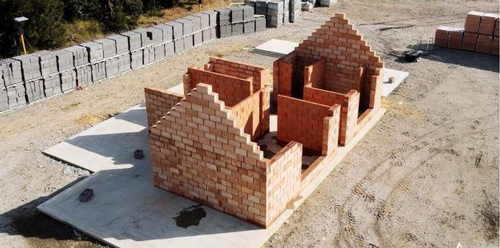WEDNESDAY, NOVEMBER 17, 2021
Australian robotics innovator FBR Limited has recently completed its first house structure using European clay blocks.
Created by Wienerberger, the bricks were assembled by FBR’s Hadrian X, a brick-laying robot. The Porotherm clay blocks are the largest produced by Wienerberger— with each R25 Porotherm being equivalent to 12 standard bricks— and were the first of its kind to be passed through the robot.
“We are very pleased to be progressing our relationship with Wienerberger, the largest producer of clay blocks in the world. Although we expected to have a Hadrian X deployed to Europe this year to complete this Pilot Program, the global conditions caused by COVID-19 have meant that we must conduct the Program here in Australia, with a view to deploying to Europe when conditions have improved such that it makes sense to do so,” said Mike Pivac, FBR’s Managing Director & CEO.
“Both parties are committed to advancing robotic construction together and improving the efficiency, sustainability and digitalization of the construction industry, and we look forward to continuing our work with Wienerberger.”

 |
| FBR Limited |
|
Australian robotics innovator FBR Limited has recently completed its first house structure using European clay blocks. |
According to reports, the project demonstrates Hadrian X’s ability to address the European clay-block low-rise housing market, which has the potential to construct up to 700,000 homes per year.
For the pilot project in particular, Hadrian X assembled the clay bricks on an outdoor test slab in a style commonly observed in Europe. The robot worked with two different block types— double leaf blocks for the external walls and single leaf blocks for the internal walls— to form a monolithic wall system. During the construction process, Hadrian X applied two separate adhesive products at different stages of the build.
The design was also noted to feature gable ends approximately five-meters-high.
FBR reports that the next step in the ongoing relationship between Wienerberger is to conduct further optimization of both the Hadrian X and the Porotherm blocks to ensure field readiness for European Pilot Programs. The company reports that it will provide updates on this optimization program as it progresses.
Residential Robotics
Earlier this year, in February, New York-based construction technology company SQ4D Inc. was reported to list a 3D-printed home for sale that it said was the first slated to receive a certification of occupancy in the U.S.
The residential property, which was printed onsite with the company’s Autonomous Robotic Construction System, was listed on MLS for sale as new construction for $299,999, in Riverhead, New York.
The 1,400-square-foot home (plus 750-square-foot garage) offers three bedrooms, two bathrooms and features an open floor plan. The building material listed reads as insulated concrete forms and SQ4D notes that the home includes the same 50-year warranty that the company puts on all of its 3D-printed structures.
The ARCS technology reportedly built the footings and foundations as well as the interior and exterior walls and the company notes that it’s a step in its mission to help aid the affordable housing crisis.
In 2019, the Great Lakes Naval Base in Illinois announced that it was undergoing a $52 million project for the construction of 166,000 square feet of new barracks for military personnel by October 2020.
The project’s general contractor, Clark Construction Group (Bethesda, Maryland) and partner Blinderman Construction (Chicago) reported that they’d be utilizing two of Construction Robotics’ (Victor, New York) machines for the job. The robots, called “MULE” (for Material Unit Lift Enhancer) and “SAM” (for Semiautomated Mason), were slated to be used in tandem for the construction project, which was a reported first for projects in the U.S.
A MULE completes all the heavy lifting— raising and placing foundation blocks weighing up to 135 pounds— while SAM can lay bricks at a pace of one every seven to 10 seconds. (SAM can also lay bricks in complex patterns and color sequences.)
A MULE costs anywhere between $70,000-80,000, while a SAM is generally leased by the week, month or longer, as each project is different and will require customized software coding.
The year before, researchers based out of ETH Zurich university announced that they’d created a new robotic construction method, which at the time, was being used to create a computer-designed modular house.
The Spatial Timber Assemblies project uses computers to design individual units, beginning with a robot sawing timber beams down to the correct size. This innovative construction process was made possible thanks to collaboration between ETH Zurich, architectural research unit Gramazio Kohler Research and timber construction firm ERNE AG Holzbau.
After a tool swap, a second robot drills the holes necessary for bolting the beams together. Using algorithms to prevent collision, two robots then work in conjunction to position the beams where needed. (A human worker is still needed to bolt the beams in place.)
According to ETH Zurich, Spatial Timber Assemblies can function without reinforcement plates “because of the required rigidity and load-bearing result from the geometric structure.” This means saved material and the creation of new possibilities.
Tagged categories: Brick; FBR Limited; Good Technical Practice; Research; Research and development; Residential; Residential Construction; Robotics; Technology; Tools & Equipment - Commercial